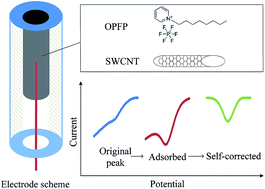Determination of methyl parathion by solid-phase extraction on an ionic liquid–carbon nanotube composite electrode†
Abstract
A novel electrode made of carbon nanotube and ionic liquid (n-octylpyridinium hexafluorophosphate) was developed for the solid-phase extraction and detection of methyl parathion (MP). The electrode effectively accumulated MP and increased the cathodic peak current. Cyclic voltammetry was used to characterize the fabricated electrode and the electrochemical properties of MP on it. Linear sweep voltammetry was used for the quantitative detection of MP. A self-correcting algorithm was exploited to isolate the small peak of MP from the large background current, obtaining a remarkable peak for MP along with a flat baseline. With a preconcentration time of 3 minutes, the peak current was linear for MP concentrations in the range from 0.1 to 2.5 μg mL−1 with a detection limit of 0.008 μg mL−1 (S/N = 3). The electrode was applied to detect MP in soil and food samples. These results indicated that the proposed method was capable of monitoring MP, providing a simple approach for routine analysis.


 Please wait while we load your content...
Please wait while we load your content...